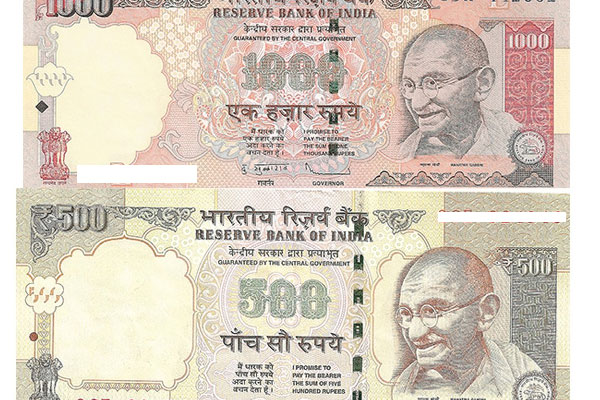In the most audacious move to curb black money since India’s independence, PM Modi stunned the nation with an announcement that existing currency notes Rs.500 and Rs.1000 will not be legal tender with effect from the midnight of 8th November (ie. From 12 am of 9th November). The move has surprised the nation and took the wind out of sails of everybody who was glued to the all-crucial US Election. Suddenly, Modi’s measures of withdrawing the highest denomination notes of this era (before the newly introduced Rs.2000 notes find their way in circulation) is touted as the biggest salvo to clean the rot in India’s Black Economy which is eating the core of the the overall economy. As per the official statement issued today, it is estimated that the size of the shadow economy (which never pays taxes and is therefore cash economy) has risen from 20.7% in 1999 to 23.2% in 2007. Another problem which compounds the issue of black money in India is the issue of Fake Currency Notes and the statistics quoted in the text of Modi’s speech is staggering. While the total number of bank notes in India between 2011 and 2016 rose only 40 per cent, the increase in number of notes of Rs.500/- denomination rose 76 per cent and those of Rs.1000/- denomination rose by 109 per cent during the same period. It is clear, these twin dilemmas must have forced the government’s hand in announcing a measure that caught everybody by surprise, including the fake currency operators as well as the hoarders.
One of the Many Moves to Curb Black Money
Modi Government has been reiterating its resolve to come up with concrete measures to tackle the menace of black money and has taken a multi-pronged approach in this direction:
One, it brought the Jan Dhan Yojana which brought crores of hitherto unbanked Indians into the banking system.
Two, the recently closed Income Disclosure Scheme which so far disclosed Rs.1.25 lakh crores.
Three, the Government systematically started tracking undisclosed foreign income and assets and negotiated redrawing of Double Taxation Avoidance Agreements between India and Cyprus, India and Mautirius, India and Switzerland etc.
Four, in many ways the proposed GST framework once it becomes a law will plug a number of loopholes which allowed different producers/resellers and providers of goods and services to stay out of tax net. Under the new rules, everybody in the supply chain will be brought into bankable turnover and incur penalties for non-compliance.
And lastly, this big bang of a move to make the notes illegal tender.
How does it Work?
In making this move, Modi has enlisted the entire paraphernalia of Central and State Governments, and the well-developed banking system led by the Reserve Bank of India and the banks besides help from statutory corporations and the Indian Police. Such a move needs a number of special arrangements and elaborate help from the Indian Banking System. Apart from emergency measures like making the withdrawn notes of Rs.500 and Rs.1000 acceptable in case of emergencies, in hospitals, essential services, railway/airport ticketing counters and petrol stations, the same can be exchanged for other legal denominations in post offices and banks (once they reopen from November 11) and RBI offices but only upto Rs.4000 till December 30, 2016. The rest is going to be credited to the bank account. ATM withdrawals are restricted to Rs.2000 per day per card with raise of upto Rs.4000 per day per card from November 19, 2016 onwards. However, cash withdrawals from a bank account over the counter is restricted to Rs.10,000/- subject to an overall limit of Rs.20,000/- in a week for the first fortnight until November 24, 2016.
No Limits on Bank transactions
Since the whole idea is to encourage bankability of transactions, all the old money of high denomination notes will be allowed to deposited into the bank accounts till December 30, 2016. As far as non-cash transactions, it is business as usual. There are no restrictions on operating bank accounts either with cheques, DDs, credit/debit cards, mobile wallets and electronic fund transfers.
How Good is this measure? What are the precedents to this measure from Past?
There have been atleast three instances in India when such withdrawal/demonetisation measures were taken by the Government of India in the past but the backgrounds were different each time and the overall objectives very different.
Going by the descending order, here is a history of precedents.
2014: The government announced steps to withdraw the special number series of Rs.500 notes belonging to the years 2009 to 2011 and before. The measure was a regular affair with sufficient timelines to withdraw the notes out of circulation and to curb fake currency rackets. It did phase the series of notes that the RBI wanted to suck out of circulation but the transition was also smoother.
1978: This happened during the Janata Government regime when the highest denomination of the era was Rs.5000 and Rs.10000 notes. The move was to capture unaccounted money which was circulated or hoarded in such high denominations. These was withdrawn in a phased manner but the primary motive behind this move was to single out the hoards of cash alleged to have been kept by Indira Gandhi and her aides post-Emergency. The move met with limited success and did not help in uprooting corruption or black money. Infact, it increased in the 1980s and led to bigger hawala trades which built the foundations for black money with foreign nexus in India today. The move also led to a rift between Morarji Desai and Charan Singh in the Janata Government when the former advised against such a measure.
1962: This happened during the heights of the Sino-Indian war when the Government of India got information that large quantities of Indian Currencies were being counterfeited by the Chinese while staging a military offensive on India. The plan was to destabilize Indian Economy while combating the Indian Army. It was then that the RBI had nullified the highest denomination of notes at that time fearing large-scale fake currency has permeated the Indian Economy. The move helped bust the fake currency racket but the war was lost by India finally.
Withdrawal of currency notes of different denominations is not new in Monetary Policy but this time around, the force and the speed with which Indian Government has acted has stunned everybody. Considering the disproportionate increase in the number of notes of these two denominations and considering that the new Rs.2000 notes is coming with additional security features, there is a possibility that this move will dent the hoarders and fakers heavily considering it caught everybody by surprise after the mega festive mont of October. As the economy matures, and black money proliferates, the tendency of the public is always to take a flight to the highest denomination of the day. The current move is going to hit at the core of those who keep large piles of cash. As long as it is legitimate and bankable, it should not worry genuine savers but if it is stealth cash, that’s where it hurts the most.
Conclusion
For the time being, large sections of unorganized segments of small and medium businessmen, politicians, real estate developers, gold and silver merchants, film fraternity, and industries which still deal in unaccounted cash will lose a lot of sleep in the coming days and months. But for India’s middle-class, Modi’s measure will rekindle hope for an India which is finally taming the monster of black money. Yes, there will be short-term pain and plenty of ramifications for Modi Government. The move has the potential to isolate Modi both from within and from outside especially Opposition which would have felt stumped at the proposal. After GST and surgical strikes, this is the measure that will get the nation in particular and the world in general salute Modi for the boldness and the speed.
























